Linear vs pivoted tonearms :
It is said that linear tonearms have tracking error across the whole record and pivoted tonearm would have atleast two null points where tracking error would be zero except the other area. Would I be wrong in saying that linear tonearm though with tracking error across the whole record is comparatively less bothersome than pivoted tonearm ? And advantage of having stylus tangent is more important ?
This linear tonearm is playing on warped record OK I think.
It is said that linear tonearms have tracking error across the whole record and pivoted tonearm would have atleast two null points where tracking error would be zero except the other area. Would I be wrong in saying that linear tonearm though with tracking error across the whole record is comparatively less bothersome than pivoted tonearm ? And advantage of having stylus tangent is more important ?
This linear tonearm is playing on warped record OK I think.
The first gen Rabco used a sensitive contact and a motor to bump it forward. they also had a version with a roller on a rolling shaft that would propel the arm forward as it pivoted. There was a Swiss copy from Goldmund that had better quality fabrication but still the same principle. The Japanese turntables with straight arms used a optical servo which would potentially be a better solution. I think the most novel (and the one I would buy) was the Transriptors Paratracker. The arm was hung from the lid. The turntable moved under the arm on horizontal slides. its a great art piece, the opposite end from my Granite turntable. I wouldn't play records, too much trouble and I'm a heretic anyway. . . Still it would look good next to my 3M M79 tape machine.
Nakamichi dragon turntable.
First was the Naka TX 1000, the Dragon followed later as a poor mans version
BTW: Linear trackers like my Goldmund T 3 F work pretty good, the computer keeps the motor almost in moving condition to avoid rumble and so on.
OTH, i have a Thales Arm, pure mechanical and this one keeps the error lower than 0,008 Degrees, so there other influences are more dominant.
And do not forget, any usual cantilever creates an error in angle H & V when there is modulation in the groove. So the tracking can not be pure straight and especially when the record is warped and the tracking arm short like Revox or similar we introduce audible problems.
So i am strictly in spheric tip, they have also the same phase deviation due the angle, but introduce lesser new problems.
Scott, sorry for responding late.Agree, from your picture above it seems your pre-amp didn't behave badly. Just what else should it do?
The preamplifier performs very well but not perfectly well. See the attached waveforms.
Vinyl track: HFN Analog Test LP (002) Side 1 Band 9: L+R 300Hz at +18dB (39.7cm/s peak)
Turntable: Thorens TD-160 Mk-II (modded),
Tone arm: SME-3009 Imp (modded)
Cartridge: Denon DL-103 (modded)
Head preamplifier: flat, 23.5dB diy based on Nat Semi AN-222 Fig.4 .
RIAA preamplifier diy based on Hagerman Bugle 1
Sound card: M-Audio Audiophile USB
Cartridge output feeds the input of head preamp.
Head-pre L Output through a Y adaptor, feeds both Hagerman Bugle RIAA preamplifier L Input and M-Audiophile USB sound card L Input.
L Output of Hagerman Bugle RIAA preamplifier is fed to R Input of M-Audio Audiophile USB sound card .
Therefore, both channels of the digital recording represent the L channel of the cartridge (L channel of the recording is the flat signal DSP amplified and DSP RIAA equalized using Audacity 2.1, while the R channel of the recording is the flat signal amplified and RIAA equalized through the Hagerman Bugle preamplifier kit)
Initial recording: 22/96 wav. Stereo via Wavelab6.
DSP manipulation applied through Audacity 2.1 to the L channel of the original recording:
Amplification 25.5db and RIAA equalization (Bugle sim)
George
Attachments
Impressive looking machine for the living room decor....... can you still buy the tape for it?
-RNM
Tape is readily available from two different Manufacturers today. RMG/Pyral in France and ATR Tape in Pennsylvania. There may be a third, but provenance is hard to track down.
available in 1/4", 1/2", 1" and 2" formats.
So, no problem.
Alan Garren
DSP manipulation applied through Audacity 2.1 to the L channel of the original recording:
Amplification 25.5db and RIAA equalization (Bugle sim)
George
Audacity is linear phase (unless you do Nyquist prompt with IIR filter) real pre-amp is minimum phase. Neither of these look badly misbehaving.
Audacity is linear phase
Scott thank you.
You have mentioned this a few times but it seems that it will never be enough for me. I keep on forgetting it.
Back to the pc
George
Scott thank you.
You have mentioned this a few times but it seems that it will never be enough for me. I keep on forgetting it.
Back to the pc
George
Not that an FIR can't be minimum phase.
Scott I quote from this site
Website of Wayne Stegall - Digital Phono Equalization
I tested this biquad in Audacity. It works OK as a IIR minimum phase RIAA filter but instead of a gain of one, it has a gain of –20dB.
Nevertheless I made up with an extra amplification.
George
Website of Wayne Stegall - Digital Phono Equalization
· Open the Nyquist prompt
Menu → Effects → Nyquist prompt...
· Enter the nyquist biquad equation that the program generated. Note: If the dialog contains a check box labeled "Use legacy (version 3) syntax," check it. My current software only gives equations in LISP format not the newer SAL.
Example at 96kHz for a gain of one:
(biquad-m s 1.315951e-02 -1.273543e-02 0.000000e+00 1.000000e+00 -1.867054e+00 8.674785e-01)
I tested this biquad in Audacity. It works OK as a IIR minimum phase RIAA filter but instead of a gain of one, it has a gain of –20dB.
Nevertheless I made up with an extra amplification.
George
Attachments
Not that an FIR can't be minimum phase.
Transforming a linear phase FIR to a minimum phase FIR is not that complicated, but the optimal design of a minimum phase FIR is a difficult mess http://users.ece.utexas.edu/~bevans/papers/1999/icassp/icassp99.pdf to the point that I would as much as possible avoid it.
Groove: you have way too many nice toys for one man 
I must admit the concept of the Thales arm intrigues me as it seems you must lose rigidity to get the alignment, but it does look wonderful and certainly nicer than other efforts in this area. I also cannot work out how Schroeder's latest prototype, which uses a straight headshell works it's magic.
I must admit the concept of the Thales arm intrigues me as it seems you must lose rigidity to get the alignment, but it does look wonderful and certainly nicer than other efforts in this area. I also cannot work out how Schroeder's latest prototype, which uses a straight headshell works it's magic.
Transforming a linear phase FIR to a minimum phase FIR is not that complicated, but the optimal design of a minimum phase FIR is a difficult mess http://users.ece.utexas.edu/~bevans/papers/1999/icassp/icassp99.pdf to the point that I would as much as possible avoid it.
See my article in LA, piece of cake with plenty of actual results. It turns out it is similar to some stuff Bruno did. Fractional delay via phase rotation to put most of the Gibb's ringing at zero rather than peaks so obvious it seems stupid. Direct FFT inversion yields in many cases small length FIR filters without windowing. 1/2 a page of Python for just about anything you want.
Last edited:
Scott I quote from this site
Website of Wayne Stegall - Digital Phono Equalization
I tested this biquad in Audacity. It works OK as a IIR minimum phase RIAA filter but instead of a gain of one, it has a gain of –20dB.
Nevertheless I made up with an extra amplification.
George
I covered the same territory in my article, it turns out a simple two pass IIR gets ridiculously close to perfect even at 44.1kHz. Last two are looking pretty similar. Wayne does have some issues when you get past the audio stuff.
EDIT - Come on George it's nice if folks read your stuff but you could go to the horses mouth.
Last edited:
See my article in LA, piece of cake with plenty of actual results. It turns out it is similar to some stuff Bruno did. Fractional delay via phase rotation to put most of the Gibb's ringing at zero rather than peaks so obvious it seems stupid. Direct FFT inversion yields in many cases small length FIR filters without windowing. 1/2 a page of Python for just about anything you want.
Which LA issue?
Have you used METEOR?
Introduction - gmeteor
To be honest this was out of the box thinking eschewing the usual academic approaches. It's free to try if it doesn't work for you, the others are all still there. I still have the gurus at work scratching their heads on this, I think it is because having a series of filters with different fractional sample delays simply does not compute. For RIAA we are talking a one pass filter the same for both channels so it does not matter.
Last edited:
Groove: you have way too many nice toys for one man
I must admit the concept of the Thales arm intrigues me as it seems you must lose rigidity to get the alignment, but it does look wonderful and certainly nicer than other efforts in this area. I also cannot work out how Schroeder's latest prototype, which uses a straight headshell works it's magic.
Those toys are all my kids, especially my Apogee speakers
Thales Simplicity is rigid. For adjustment there is a gauge delivered, you mount the cartridge on the sub-headshell,adjust with gauge, thereafter you insert it into mainheadshell, tighten 2 screws, done. The bearings are from the watch industries and a watchmaker adjust them. The arm parts are mainly assembled with modern glue, thus no tolerance shift.
The new MkII is said to be better due some mods, but i am happy, when listening records i never have the idea to mod something, just have fun.
- Status
- Not open for further replies.
- Home
- Member Areas
- The Lounge
- John Curl's Blowtorch preamplifier part II



